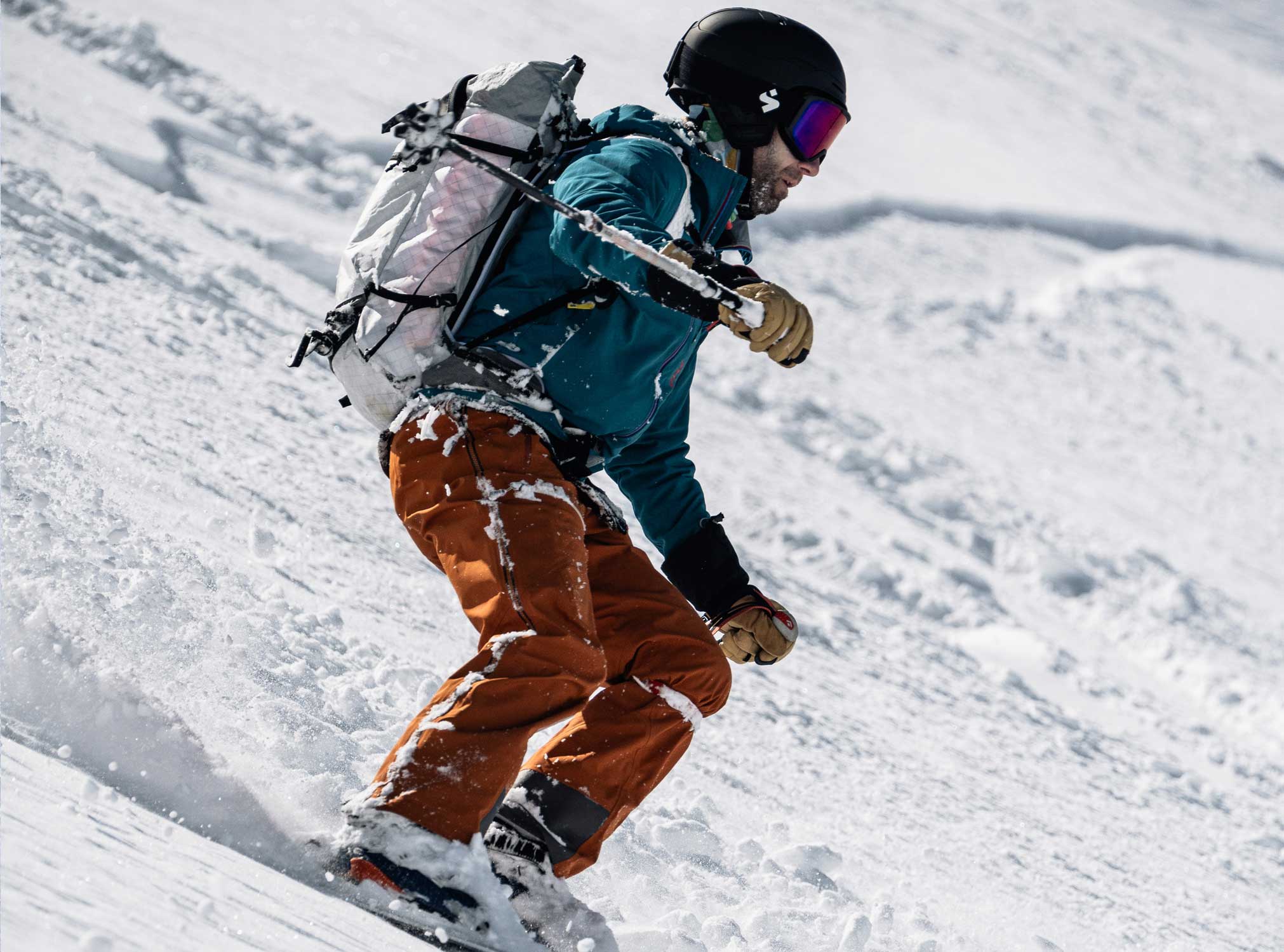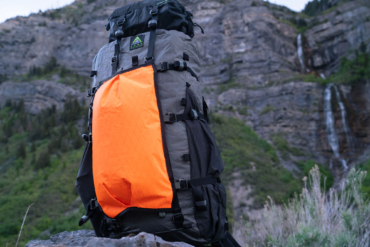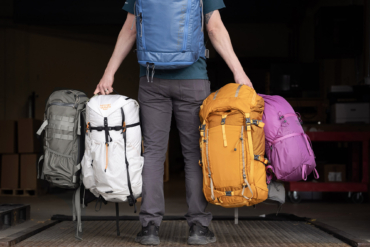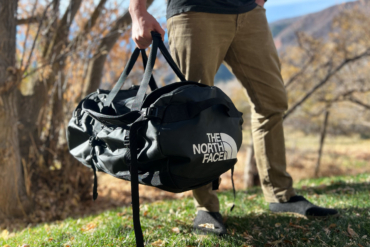Finally, a haul bag for fast and light objectives!
Traditionally, haul bags — or “pigs,” as the wall climbing faithful call them — are massive wearable voids that climbers use to transport hefty loads up vertical terrain. To this day, most haul bags on the market are heavy and bulky, like soft-sided oil drums with backpack straps. Popular models like the Metolius Half Dome and the Black Diamond Zion offer 100+ liters of storage and weigh over 8 pounds.
Loaded down with rope and water, these behemoth haul bags are a literal pain to carry. Back in mid-century Yosemite, climbers opted to simply huck their haul bags off the top of El Capitan instead of humping them down the descent trail. This practice is long since illegal and frowned upon, but the point is that heavy haul bags will make a climber do kooky things.
Now, Grade VII Climbing Equipment introduces the Haul Pack, an ultralight bag with a fresh design that intends to change the big wall and alpine climbing game.
In short: G7’s Haul Pack is not in the same category as the Zion or El Cap haul bags. It is not designed to replace larger bags on weeks-long siege-style expeditions. Instead, the Haul Pack represents a recent progression toward new-age big wall tactics and light ’n fast free ascents. It weighs very little, it’s versatile, and it’s durable enough to haul on all rock types.
G7 Haul Pack Review

Crag Bag Test
We tested the Haul Pack in two sizes: 22L and 55L. Before hitting the alpine for a thorough multipitch haul test, we used both sizes of Haul Pack for standard everyday commutes to the sport cliff. While cragging isn’t the primary intended use of the Haul Pack, this application allowed us to get a basic feel for the packs’ comfort, feature set, and carrying capacity.
The 22L Haul Pack is just large enough for a basic sport climbing kit. With 12 quickdraws, two pairs of shoes, a puffy jacket, and the rest of the standard bolt-clipping accouterments, the 22L is jam-packed. Once loaded with the personal essentials, a rope won’t fit inside. Instead, the bag’s single buckle strap and innovative exterior bungee system can securely carry a coiled 80m rope without issue.
For trad cragging, we tested the 55L against Black Diamond’s Creek 50, which is considered the gold standard pack in crack climbing hotspots like Index and Indian Creek. Though the 55L Haul Pack claims to have more than 5 extra liters of storage than the Creek 50, we found it much more difficult to pack and unpack at the cliff.
The Haul Pack has an aggressively tapered shape. It’s far narrower at the base than it is at the opening. We managed to cram a full kit — including a double rack of cams and 80m rope — in the 55L Haul Pack, but it was stuffed to the brim and certain items were in danger of spilling out.
Once tightly packed, the Haul Pack’s tapered shape makes it difficult to retrieve gear out of the slender bottom. The main cavity can only be accessed via the top opening.
We had to literally turn it upside down and shake it to retrieve our tightly stuffed cams out of the bottom. Meanwhile, the Creek 50 is cylindrical, and its depths can be accessed effortlessly from the top or via the front zipper.
We understand that the Creek is designed for single-pitch cragging and the Haul Pack is not. Cragging with the 22L and 55L Haul Pack gave us an opportunity to get to know its strengths, weaknesses, and features.
Overall, the Haul Pack is a serviceable crag pack in a pinch. Its large grab/haul loop and excellent external rope-carrying system are effective in every climbing scenario — single pitch or otherwise. Still, the Haul Pack shines brightest in multipitch and alpine terrain.
As a Haul Bag

We tested the 22L Haul Pack while climbing multipitch classics in the Cirque of the Towers, an alpine climbing hotspot that makes Chamonix look like a local choss pile.
To assess the Haul Pack’s hauling capability, we utilized a tagline that the leader used to pull up the bag while the follower climbed. This strategy meant we were never forced to climb while wearing the pack.
In recent seasons, hauling a small pack on a tagline has become a standard tactic for in-a-day free routes. We expect that most climbers will use the Haul Packs in this system, especially the 22L and 36L versions.
Unlike most haul bags on the market, the Haul Packs only have a single clip-in point or “haul loop.” Though this design lacks redundancy, we never felt worried that the half-inch nylon webbing would cut or tear while hauling.
The haul loop is bar-tacked to the pack body in four places with super-strong Vectran-based fiber. Every bar tack is protected by a laminated layer of TPU film.
The lengthy haul loop makes the bag easy to dock to the anchor. We did find that the tapered shape on the bag makes it difficult to retrieve gear from the bottom while hanging at a belay.
The offset opening of the bags, which is exaggerated on the 55L, does come in handy while rummaging, but we still struggled to access the bottom of the bag without unpacking it entirely.
While hauling, the Haul Pack remains upright and centered. The shoulder straps don’t detach and stow away, which could cause it to snag more than other haul bags. But we have never had an issue over numerous pitches of hauling over low-angle granite, chimneys, and roofs.
G7 claims the Haul Packs are more durable than traditional haul bags. The simple two-layer construction combines TPU polyamide composite outer fabric with a thin expanded polypropylene foam backing.
In our testing, the 22L pack held up remarkably well to over 10 pitches of hauling. Most pitches were less than vertical, and the pack rubbed against the abrasive crystalline surface for an estimated 1,000 feet of terrain. By the end of the trip, a few minor scuffs were the only sign of wear.
The shoulder straps didn’t tear, and the exterior bungee system looked good as new.
We’ve climbed multipitch routes with most of the climbing-specific day packs and small haul bags on the market, and the G7 Haul Pack has quickly become our top choice. The 22L is slightly bigger and bulkier than the popular 18L REI Co-op Flash, but it comes with a huge added bonus: It’s durable enough to haul.
Most other 15-35L alpine climbing packs on the market would rip to shreds if used as a haul bag. Meanwhile, most similarly sized haul packs are much heavier than G7’s.
For example, the 35L Black Diamond Stubby weighs 3 pounds, 15 ounces. The 36L Haul Pack weighs 1 pound, 4 ounces.
As a Follower Pack

On easier pitches, we wore the Haul Pack while climbing. In general, we found its streamlined body-hugging shape to be relatively unobtrusive.
We wore the 22L Haul Pack for a total of 20 pitches of moderate alpine climbing over 2 days. Even after it was loaded with about 8 pounds of jackets, water, and snacks, it was fairly comfortable for consecutive hours of wear. Our shoulder mobility remained intact, and we only had to remove the pack for a few pitches of tight squeeze chimneys.
The Haul Pack’s back panel is noticeably thinner than most climbing packs on the market. If packed carelessly, the corners of cam lobes or carabiner noses will create pressure points for the wearer.
All three Haul Packs have a single small flat internal pocket with a waterproof zipper, but it’s just large enough for a phone, or paper topo. Most guidebooks won’t fit.
By the end of the second day of climbing, the flat, unpadded suede shoulder straps did cause discomfort, but they still felt better than expected given their bold pad-free design. G7’s design choices are aimed at weight reduction. The straps and back panel aren’t plush, but this minor deficiency is an understandable tradeoff for weight savings in a piece of big wall gear.
Standout Features

As G7 proved with its POD inflatable portaledge, radical innovation is among the brand’s core tenets. The Haul Pack is the product of a decade of research and development, and it’s a legitimate step up from all existing similar products.
The Haul Pack’s shape and opening took some getting used to, especially on the 55L. In lieu of a brain-style lid, roll top, or zipper, the Haul Packs close with a drawstring. When the drawstring is cinched down, the tapered opening seals completely to protect against rain and spillage. However, when stuffed to the brim, the effectiveness of the drawstring plummets.
Unlike most drawstring closures, the Haul Packs do not have an exposed cord lock mechanism. Instead, the mechanism that keeps the cord cinched is incorporated into the bag’s material. To open the bag, simply reach into the opening and pull it apart.
At first, we were unsure if the hidden cord lock would keep the bag closed. In theory, a tree branch on the trail could snag the bag and pull it open. During testing, the integrated cord lock remained secure on both the 22L and 55L packs.
We appreciate that the Haul Pack has minimal frivolous cinch straps and buckles. The Haul Pack has a clean and tidy outer surface. With exterior storage in mind, G7 developed a nifty removable bungee cord that is easily the best coiled-rope carrying system on the market. The bungee itself is coated in Dyneema, and it hasn’t ripped or lost elasticity even after several months of heavy use.
Though the bungee is a clever, lightweight stand-in for straps and buckles, it does occasionally feel like a nuisance. The 22L pack comes with the same length bungee as the 55L, and it dangles nearly to the knees when it isn’t being used to secure a rope.
There are numerous ways to tie up the bungee so it’s out of the way, but it poses a minor problem that other packs don’t have. On the 55L pack, the bungee is the perfect length and rarely gets in the way.
According to the brand, the bungee can also be used to attach crampons or skis to the Haul Pack, but we haven’t tested this application.
Conclusion

Ultimately, the Haul Pack’s main appeal is its incredible durability-to-weight ratio. The Haul Pack is the lightest haul bag or alpine pack on the market in all three sizes.
To balance its feathery weight and cutting-edge design, the Haul Packs come at a high cost. At retail, the 22L will cost $255, the 36L will cost $345, and the 55L will cost $425. For context, the 157L Metolius El Cap Haul Bag costs $280.
No matter the price, the Haul Pack is a game-changer in the big wall free climbing sphere, just like the brand’s POD inflatable portaledge. As soon as the Haul Pack begins shipping in spring 2023, it won’t be long before it’s a standard part of everyone’s El Cap kit.
All three sizes of Haul Pack can be preordered on Indiegogo for 20-33% off.









